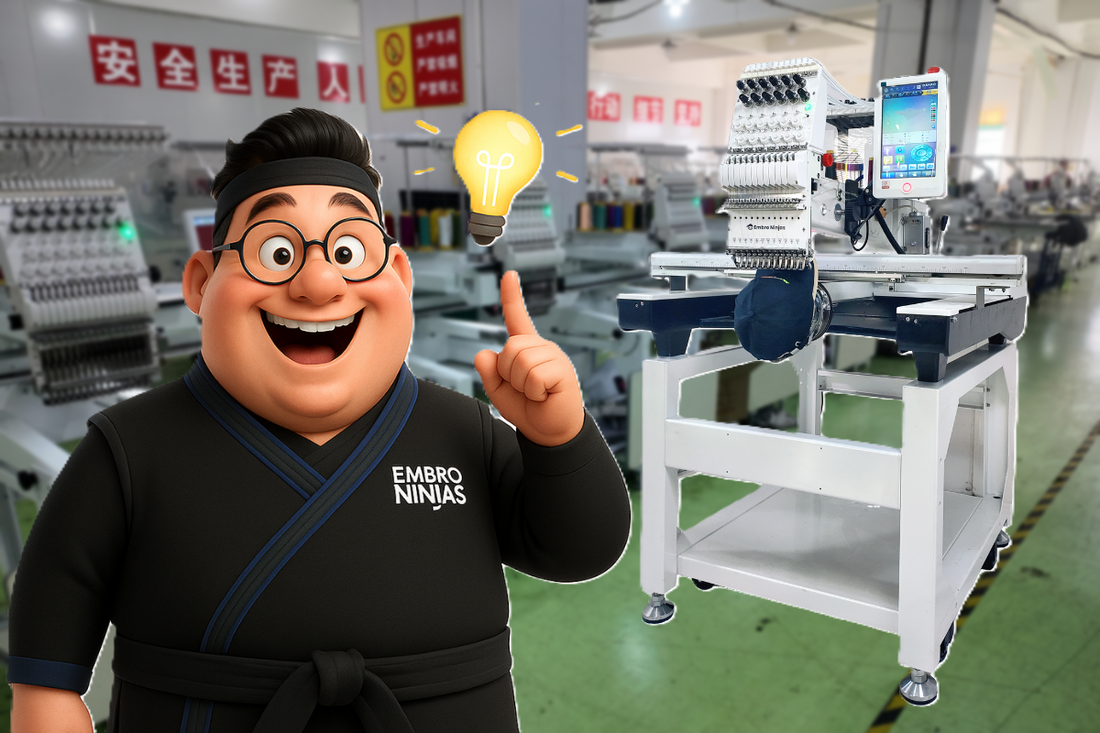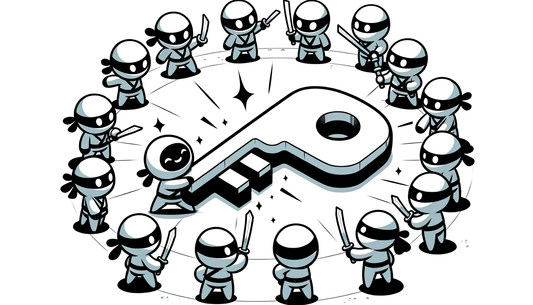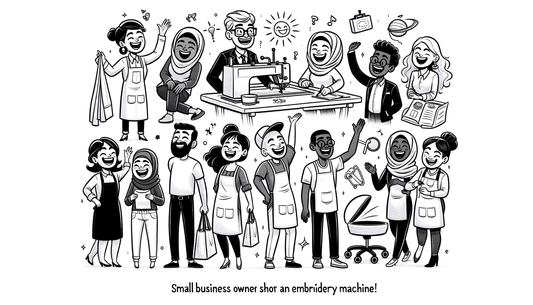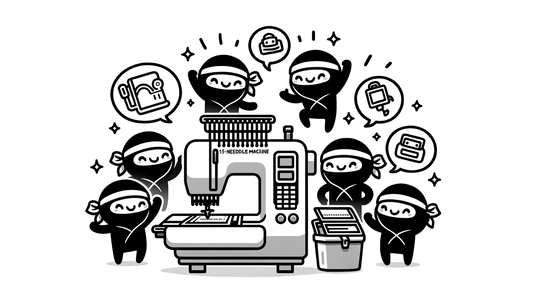
Top Embroidery Machine Hacks from Social Media Pros
Share
Embroidery is both an art and a craft, blending creativity with technical skill. Whether you're a hobbyist or run a bustling embroidery business, efficiency is key. Social media groups and online communities are treasure troves of practical tips and tricks. Here, we've compiled the top 10 embroidery machine hacks, gleaned from seasoned pros in these communities, designed to save you time, boost creativity, and troubleshoot common issues.
Time-Saving Tips and Shortcuts
Efficiency starts with organization and preparation. These hacks will streamline your workflow, letting you focus on the artistry of embroidery.
-
Hoop Order: Arrange your embroidery hoops from smallest to largest. This simple organization hack, also highly recommended in the https://www.embroninjas.com/blogs/news-1, drastically cuts down the time spent searching for the right size, speeding up production.
-
Labeled Threads: Label each thread spool with its corresponding needle number to match your design's color sequence. This eliminates guesswork, ensuring swift and accurate thread changes during large, multi-colored runs.
-
Backup Supplies: Keep extra hoops and pre-threaded bobbin cases readily available. When a bobbin runs out mid-project, you can swap in a new one in seconds, minimizing downtime and frustration. It is recommended that you keep extras of each kind of embroidery item ready.
-
Multitasking Mastery: While your machine is stitching the current item, use the downtime to prepare the next one. Trim threads, remove stabilizer, or prep the fabric for hooping. This maximizes your productivity without adding extra hours to your day.
-
Keyboard Shortcuts: Master the keyboard shortcuts in your embroidery digitizing software (like Hatch, Wilcom, or BERNINA V8).
- '1' fits the design to the screen, '0' zooms in.
- 'B' activates the zoom tool; use arrow keys for incremental adjustments.
- 'D', 'T', 'S', and 'L' toggle artwork, stitches, outlines, and other display features.
- 'Ctrl+S' (Windows) or 'Command+S' (Mac) saves designs quickly.
- 'Ctrl+Tab' adds the next object to the selection; 'Ctrl+Shift+Tab' selects the previous one; 'Esc' or 'X' deselects all.
-
Organized Workstation: Arrange your materials and tools within easy reach. A well-organized workstation minimizes the time spent searching for items, contributing to a smoother and faster workflow.
Creative Usage Techniques
Think outside the box! These hacks repurpose everyday items and tools to solve unique embroidery challenges and expand your creative possibilities.
-
Non-Sewing Solutions: Get creative with non-sewing items to solve embroidery issues. For example, a plastic container can prevent fabric from slipping under the needle, ensuring consistent stitch quality.
-
Rotary Cutting: Employ rotary cutters and self-healing mats for fabric cutting. Compared to scissors, they offer faster, more precise cuts, which is especially useful when preparing multiple pieces for larger projects.
-
Precision Marking: Use screw punches to mark pattern points quickly and accurately. This ensures consistent embroidery placement, reducing errors and rework.
-
Stabilizing with Tape: For tricky fabrics that resist hooping, community members suggest using temporary adhesive sprays or even painter's tape to hold the fabric securely in place. Always test on a scrap piece first!
Troubleshooting Community Solutions
Embroidery isn't always smooth sailing. These community-sourced troubleshooting tips will help you quickly resolve common issues and get back to stitching.
-
Pre-Threaded Bobbins: Keep extra bobbin cases pre-threaded for instant replacement. This is a game-changer when a bobbin runs out mid-stitch, minimizing downtime and frustration.
-
Regular Maintenance: Make machine maintenance a routine, not an exception. Regular cleaning and lubrication prevent issues before they arise, saving you time and headaches in the long run. Maybe it's time to consider purchasing with us, visit https://www.embroninjas.com/pages/customize-your-embroidery-machine
-
First Steps for Thread Breaks: If you experience thread breaks or tension issues, always check both the top and bottom threading first. Swap in a pre-tested bobbin or needle to rule out common causes. If you're seeking your first entry into the commercial space, you may consider the NinjaStarter
Popular Group Recommendations
Tapping into community knowledge is one of the best ways to improve your embroidery skills and efficiency.
-
Logical File Storage: Organize your design files logically on your computer or USB drive. A clear file system makes it easy to find and load designs quickly when prepping orders.
-
Time Tracking: Time each step of your process (hooping, stitching, trimming) to identify bottlenecks. This data-driven approach helps you pinpoint areas for improvement and optimize your workflow. Maybe it's time to consider purchasing with us, visit https://www.embroninjas.com/pages/customize-your-embroidery-machine
-
Share and Learn: Actively participate in your favorite embroidery groups. Sharing your own hacks and asking for advice from others is a continuous learning process. If you're looking to learn more tips and tricks come join our virtual demo: https://calendly.com/embroninjas/30min
These hacks, endorsed by online embroidery communities, offer actionable ways to streamline both the creative and operational aspects of machine embroidery. By implementing these tips, you can unlock greater efficiency and take your embroidery projects to the next level. You can get more helpful tutorials at https://www.embroninjas.com/blogs/news-1. And for those ready to take the plunge, consider exploring high-quality, affordable options from a trusted source like Embro Ninjas. Embro Ninjas are backed by over 30 years of experience. More about the brand can be found here: https://www.embroninjas.com/pages/about-us
What people also ask?
Question: How often should I clean my embroidery machine?
Answer: You should clean your embroidery machine after every 8 hours of use, or more frequently if you notice excessive lint or thread buildup.
Regular cleaning prevents issues and ensures smooth operation. Use a small brush or vacuum to remove lint and debris from the bobbin area, needle plate, and thread paths. Lubricate the machine according to the manufacturer's instructions. Neglecting regular cleaning can lead to tension problems, thread breaks, and decreased stitch quality.
Question: What's the best way to store embroidery thread?
Answer: The best way to store embroidery thread is in a cool, dark, and dry place, away from direct sunlight and extreme temperatures.
Options include thread racks, drawers, or plastic containers. Organize threads by color or brand for easy access. Proper storage prevents fading, fraying, and tangling, extending the life of your thread. For added protection, consider using thread nets or bobbins to keep the ends secure.
Question: How do I choose the right stabilizer for my embroidery project?
Answer: Choosing the right stabilizer depends on the fabric you're using and the density of your design.
Lightweight fabrics require lightweight stabilizers, while heavier fabrics need more support. Cutaway stabilizers are ideal for dense designs or stretchy fabrics, while tearaway stabilizers work well for simpler designs on stable fabrics. Experiment with different types to find what works best for your specific project. Consider a visit to our blogs to help you learn: https://www.embroninjas.com/blogs/news-1
Summary: Unlock your embroidery potential with insider hacks for organization, creativity, and troubleshooting. Whether optimizing your workspace or mastering software shortcuts, these tips can significantly enhance your efficiency and quality.


